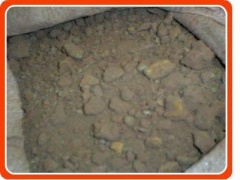Copper Cement
| Infobox on Copper Cement | |
|---|---|
| Example of Copper Cement |  |
| Facts | |
| Origin | - |
| Stowage factor (in m3/t) | - |
| Humidity / moisture | - |
| Ventilation | See text |
| Risk factors | See text |
Copper Cement
Description / Application
Cement copper (precipitated copper) is a product obtained by precipitation (cementation), i.e., by adding iron to the aqueous solution resulting from the leaching of certain ores or waste. It is a finely devised black powder containing oxides and insoluble impurities. Cement copper is often added to the charge which goes to a converting furnace to produce copper matte.
Copper matte is obtained by fusion of roasted copper sulphide concentrates or ores to separate the copper sulphide from the gangue and other metals which form a slag that floats on the surface of the melt. The matte consists essentially of copper and iron sulphides and is generally in the form of black or brown granules (obtained by pouring the molten matte into water) or crude mass, with a dull, metallic appearance. However, the majority of matte is never solidified but transferred by ladle while molten to a convering furnace. Most matte never enters the market place.
Note: Cement copper must not be confused with copper powder, which does not contain impurities.
Shipment / Storage
Moisture content is critical, may liquefy. Because of the risk of possible heating or spontaneous combustion, the temperature should be checked before loading. The temperature may not be higher than the local daytime outside temperature.
With regard to stowage and ventilation :
1. Preferably in containers, on deck. The containers need to be waterproof.
2. For carriage below deck, following guidelines to be taken into account:
- To stow in the upper positions, within reach and away from heat sources.
- Bags to be stowed on gratings, or double dunnage, allowing ventilation underneath as well
- In case of heating, or increasing temperatures only, cargo to be watched closely and jettisoned, If necessary.
- Every 4 hours check temperature, in various spots and note.
Good ventilation is necessary, in particular during loading/ discharging.
Risk factors
Copper cement may cause headache/drowsiness due to small traces of arsenic antimony.
Consult applicable MSDS sheet
See also Metallic Copper











